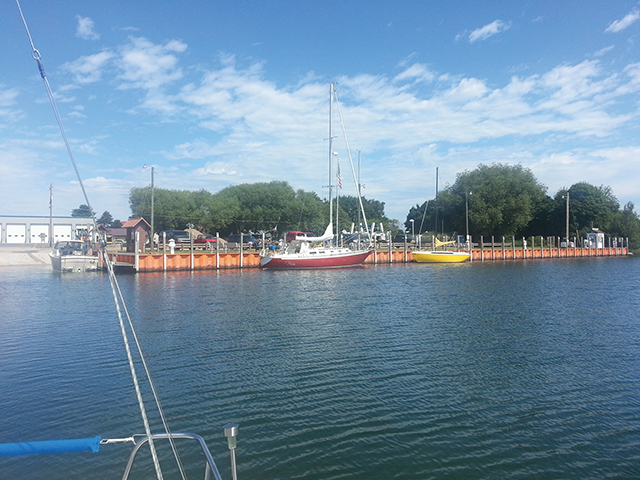An educational voyage on Lake Superior creates lasting memories (published May 2014)
“Now Mother Nature’s just being bitchy,” I joked as the rain changed to sleet while we were motoring down the Portage River in the Keweenaw Waterway. We had just completed our first overnight on Lake Superior as She put this final touch on an exciting few hours of sailing.
The overall purpose of our voyage was to sail from Bayfield, Wisc. to Sault Ste. Marie, Mich. as students in an Advanced Coastal Cruising (ACC) class. Our crew consisted of Captain Tony Green, Art and Cathy LaPoint, my husband Michael and me. This was Michael’s and my first crossing on Lake Superior, so everything was new to us. We’d started sailing the spring before, and had completed ASA 101, 103, 104, 105 and 114. Other than the boats we’d sailed in our ASA classes, our experience consisted of sailing a Hunter 23 on the St. Croix River.
Docked at Pike’s Bay Marina in Bayfield, Wisc., the vessel we used for our class was an Islander 36 named Aerie. Choosing Sault Ste. Marie as our destination served two purposes: Cathy, Michael and I got to complete ACC as we delivered Aerie to a team who would sail her back to Duluth as participants in the Trans Superior International Yacht Race. We sailed along with sister ship, Endeavor, whose crossing also served this dual purpose.
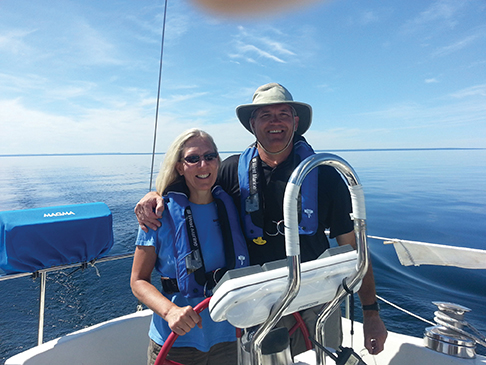
READY, SET, GO
Our voyage began on Saturday, July 27, 2013, at approximately 2 p.m. Prior to setting sail, we completed some minor boat repairs, adjusted the tension on the shrouds, attached the jack lines, secured the life raft and loaded on our provisions.
Northerly winds measured nine knots when we set sail and it was misting but pleasant. We decided to take the overnight shifts with our spouses in three hour intervals. On this summer evening in late July I had my foul weather gear on, and underneath it I was wearing a pair of pants, a long sleeved shirt, a sweatshirt and a fleece shirt. My outerwear also included winter gloves—the sailing gloves didn’t cut it—, a stocking cap (thank you Cathy), and the hood from my foul weather jacket. This outfit barely kept me warm. Did I mention it was July?
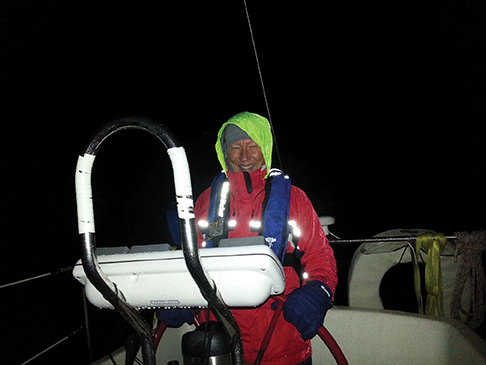
Michael and I took the first watch from 9 p.m. to midnight. This was our first time sailing at night and I didn’t know what to expect, but our watch was relatively uneventful. The north-northeast wind ranged from 8 to 10 knots, the sky was cloudy and our speed ranged from 4.2 to 5.3 knots. As a person who thoroughly enjoys a good night’s sleep, I didn’t think I would appreciate night watches, but this watch was very enjoyable. Michael and I each took the helm for an hour during the first two hours of our watch, then split the last hour with 30-minute intervals at the helm.
THE FUN BEGINS
The excitement started towards the end of Michael’s and my 3 a.m. to 6 a.m. shift. Tony and Michael put in the first reef during the last hour of our shift. But by the time Cathy and Art joined us in the cockpit at 6 a.m., we were overpowered and it was clear that a second reef was needed, if not overdue. I offered to go up to the mast and Tony asked me if I had ever worked a locking winch before. When I said no, he replied, “This is not the time to learn.” (Aerie was built in the 1970’s. Her mainsail halyard is a wire that wraps around a winch that has a locking mechanism. I had not sailed this boat before, so I was not familiar with the winch.) So Michael and Tony put in the second reef while I took the helm.
After helping Tony put in the second reef, Michael stayed in the cockpit for a while then went to the V-berth to sleep. I suffer from motion sickness and didn’t think I would be able to sleep, so I stayed in the cockpit with Cathy and Art. To combat my motion sickness I take Bonine when I sail and it works like magic. On this particular voyage, though, the seas stretched Bonine’s effectiveness to the limit. But I still stand by it, as I did not lose my lunch.
Art took the helm after we put in the second reef. He has a fair amount of sailing experience— he’d passed ACC long ago—so he managed the boat very well. He almost made it look easy.
Between 6 a.m. and 10 a.m. the northwesterly winds measured 20 plus knots with gusts to 30, and the lake delivered four to six foot waves. We buried the starboard toe rail more times than I can count. It rained continually and as if we weren’t wet enough, the waves sprayed over the windward side of the boat just to remind us that they were there. I took note that purchasing a pair of sea boots would be a good idea before my next Lake Superior crossing.
Cathy was a bit hesitant to take the helm in those conditions, but after a short time, she was managing the boat like a pro. When I took my turn at the helm, I was faced with a situation that was completely new to me. Almost immediately, two waves hit Aerie back to back and the water came up over the starboard toe rail onto the deck about eight inches both times. I believe I said something like, “I need some coaching.” I don’t believe my voice was completely calm. Cathy came and stood to the port side of the helm and did her best to talk me through the process of steering the boat.
After about ten minutes I was feeling more confident. It was at that time that Cathy uttered two very helpful questions: “Do you want me to stay here? Am I being helpful?” Yes, I wanted her to stay a bit longer. Yes, she was being most helpful. It wasn’t long before I thanked her and told her I didn’t need her at my side anymore. As most sailors know, it is empowering to “read” your boat and sail her as she wants to be sailed.
It was an eventful four hours and being the helmsperson took a great deal of concentration. We were primarily on a beam reach so the waves hit us broadside. For those of you who have sailed Lake Superior before, you know that the waves are somewhat unpredictable and strike quickly. In addition to the challenge the waves provided, it continued to rain.
By the time we were within striking distance of the entrance to the Keweenaw Waterway, we were more than ready to head into calmer waters. We dubbed the white tower marking the entrance to the Waterway, “The Best White Tower EVER!” We started the motor, lowered the sails and headed in. It was while we were motoring on the Portage River that the rain changed to sleet. We thought Mother Nature went a little over the top at that point.
A WELCOMED REST
We docked overnight at the marina in Hancock, Mich. on the north side of the Keweenaw Waterway just beyond the Portage Lake Lift Bridge. We had originally planned to dock on the Houghton side, but the Hancock side had hot showers and dryers. After cleaning up a bit, we walked across the lift bridge to Houghton for a beer—Michael and I had a Lift Bridge Brown Ale in honor of the structure—and some eats.
We awakened the next morning to clear skies, sun and very little wind and were underway by 11 a.m. The trip through the Waterway was peaceful and beautiful. We exited the Waterway at 1:20 p.m. and turned off the motor. What a difference from the previous day. The winds were so light that we started the motor again at 3:45 p.m. and didn’t turn it off until 8 p.m. when the breeze finally picked up.
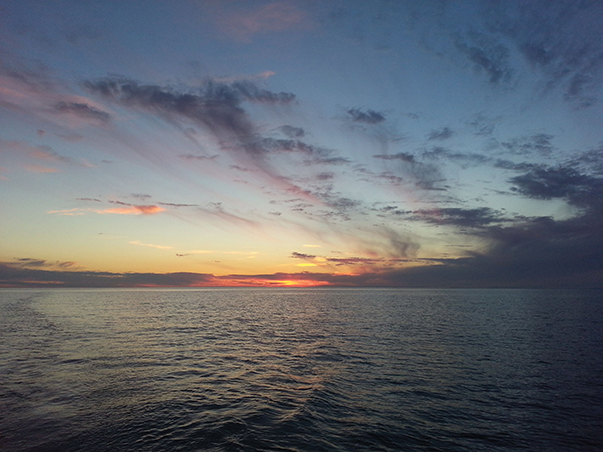
We elected to switch to four-hour night shifts in an attempt to get an extra hour of sleep. After sleeping soundly for a few hours, Michael and I took the 2 a.m. to 6 a.m. shift. By now the winds were a steady 7 knots out of the south, southeast and southwest. The sky was clear and the stars were just plain showing off. It was very peaceful. Tony came on deck at about the same time we started to see a small orange spec on the horizon. It gradually grew to the size of a distant shark fin. Tony asked us if we knew what it was. We didn’t. In just a few minutes it appeared to be an orange glowing sail. Why would a sailboat shine an orange light on its sail? Tony told us we’d laugh when we figured out what it was. We did. It was a crescent moon rising. What a beautiful sight to see.
We arrived at Burt Township Marina, Grand Marais, Mich. at 10 a.m. on Tuesday. We walked a few blocks to get breakfast then Michael and I paid 50 cents each at the local campground to take a shower. Shortly thereafter, Cathy, Michael and I took our ACC test (we passed!) and headed back out to sea.
The day was warm and partly sunny with light winds. We motored out of the marina and continued motoring for a couple of hours. The wind picked up and we raised the sails and practiced man overboard maneuvers. We continued to chase the wind so we could sail rather than motor, but finally decided to drop the sails, motor and get back on our actual route, which faced directly into the wind. Technically, we could have tacked, but the winds were so light we elected to use the engine.
LAST HURRAH
Our final night at sea was both calm and enchanting; it was also warm enough to ditch the winter gloves. Cathy and Art took the first watch. At some point they saw a mysterious long line of red lights. They checked the chart and there was nothing indicating that these lights existed so they awakened Tony, who told them that there was a wind farm on Ile Parisienne. The lights apparently warn low flying aircraft that huge wind turbines are in their flight path.
When Michael and I started our watch, Art and Cathy had already rounded Whitefish Point. A freighter passed us far to our port side in the deep of night. It was interesting to first see its bow and stern lights far astern of us and to watch them grow larger until the freighter finally moved past us and left us in its wake.
We reached the Ile Parisienne Light after sunrise. A freighter had trailed us for some distance by the time we reached Gros Cap Reefs and we fully expected it to pass us, but it never did. Since freighter traffic trumps a sailboat in the locks, Tony suggested we go through the Sault Ste. Marie Canal Lock, which is in Ontario, Canada, rather than the American locks. As you near the locks a yellow-black-yellow buoy marks the junction between the Canadian and American side. To get to the Canadian lock, we kept the yellow-black-yellow buoy to our starboard side.
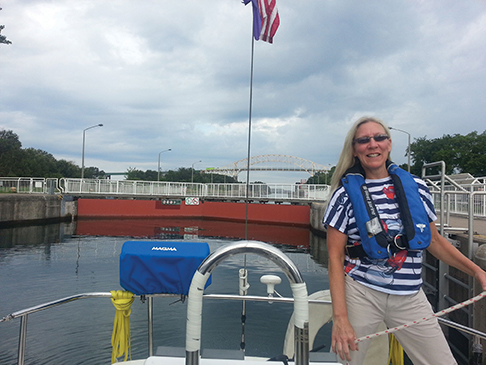
Tony hailed the Canadian lock but no one responded. He tried a couple of times then switched to an international frequency. Someone answered and informed us that the Canadian lock didn’t open until 9 a.m. It was about 8 a.m. at the time. While we waited, we tied up to the bollards on the canal wall and when we got the green light, motored into the lock and tossed our bow and stern lines to the man ashore. He threaded our lines through the vertical guides that line the lock wall and tossed the lines back to us. As the water level decreased, our lines slid down the guides and kept Aerie in place. Pretty slick.
Upon leaving the lock, the end of our journey was in sight. The final docking was bittersweet. Michael and I knew we’d see everyone at dinner that night, but goodbyes would be exchanged the next day. We’d only spent a few days together, but a bond had been formed, at least for me. I developed an immense amount of respect for Captain Tony. He is an incredible teacher. He is patient and firm, intelligent and funny. As for our fellow crewmembers, we were blessed to sail with Art and Cathy and hope to sail with them again in the future. It would be difficult to find two more amicable, intelligent and wonderful people with whom to sail.
We returned home to Woodbury, Minn. on Thursday night, and on Friday night I was in the Palmer House Hilton Hotel in Chicago, Ill. with my son, Kyle and our dog, Marcus. What a change from a cramped sailboat. In my dreams, I was still sailing.
Cindy Egeness lives in Woodbury, Minnesota. She and her husband Michael have five children, six grandchildren, and a big dog that thinks he is a lap dog. She enjoys working at St. Catherine University and—in her off-work hours—spends time socializing, running, biking, reading, and, of course, sailing.















